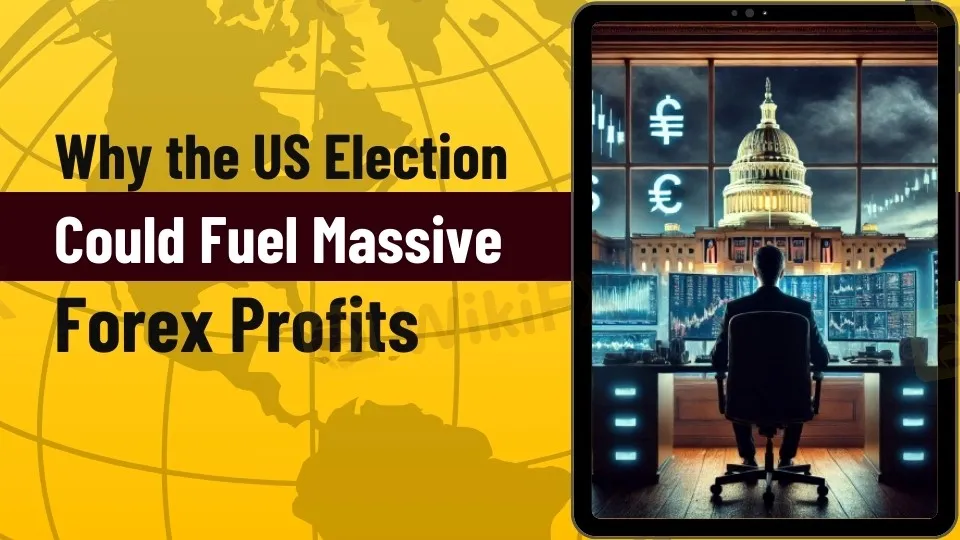简体中文
繁體中文
English
Pусский
日本語
ภาษาไทย
Tiếng Việt
Bahasa Indonesia
Español
हिन्दी
Filippiiniläinen
Français
Deutsch
Português
Türkçe
한국어
العربية
Why the US Election Could Fuel Massive Forex Profits
Abstract:The US election sparks forex trading opportunities. Trump's economic policies may increase volatility, offering potential gains for traders.

The upcoming US election is sparking major opportunities for forex traders worldwide. As market-moving news unfolds, Donald Trump's economic policies are shaking up the financial landscape. Traders are gearing up to profit from the expected volatility. With global markets bracing for turbulence, the potential for significant gains has never been higher.
Trump's Economic Policies and Their Impact on Forex Trading
Trump's economic agenda, including promises of inflation control and higher tariffs, has traders and economists on edge. Experts warn these policies could cause a sharp rise in prices, rather than stabilizing inflation. Nobel Prize-winning economists predict inflation could soar to 9.3%, increasing forex market volatility.
For forex traders, this creates golden opportunities to trade USD pairs and safe-haven assets. The volatility driven by these policies opens doors to profit, especially for those using platforms like Exness, which offers tight spreads and advanced trading tools.
Trading USD Pairs and Safe-Haven Assets During Election Volatility
As election day nears, the US dollar is expected to fluctuate, bringing increased volatility to USD pairs. Key pairs to watch include EURUSD, USDJPY, and USDCAD.
· EURUSD: Inflation concerns may weaken the USD, leading to major price swings. Expect frequent trading opportunities in this pair as inflation reports emerge.
· USDJPY: In uncertain times, traders often flock to safe-haven currencies like the yen. Watch for sharp movements as market sentiment reacts to Trump's policies.
· USDCAD: North American trade is central to Trump's policies. USDCAD could see strong moves, especially if tariffs disrupt trade and impact oil prices.
Gold, Silver, and Commodities as Safe-Haven Assets
Safe-haven assets like gold (XAUUSD) and silver (XAGUSD) stand to gain from market turbulence. Gold, a proven hedge during inflationary periods, is crucial to watch as traders protect against a weakening USD. Silver, used in industrial production, may see increased demand as tariffs raise manufacturing costs.
Commodities such as WTI crude oil (USOIL) and natural gas (XNGUSD) are also likely to react to Trump's policies. Supply chain disruptions and rising inflation could push prices higher, offering prime opportunities for traders focused on these markets.

Key Forex Pairs to Watch
Beyond USD pairs, other major forex pairs like AUDUSD and GBPUSD will likely see significant movement:
· AUDUSD: Australia's strong reliance on China means Trump's tariffs could ripple through this pair, creating dynamic trading conditions.
· GBPUSD: A weakening USD, combined with political events in the UK, could boost the pound, making GBPUSD an active pair during this period.
Best Strategies for Trading Volatility
Trading forex during an election cycle can be challenging but rewarding. The key is to stay informed and nimble, using platforms like Exness to track live market updates and execute trades quickly. Exness provides the tools needed to monitor price movements, ensuring no opportunity is missed.
To maximize profits during volatility, traders must go beyond traditional buy-and-hold strategies. The ability to short assets allows traders to profit in any market direction. As Trump's policies continue to influence market sentiment, staying ahead of the curve is crucial to success.
Conclusion
The US election is set to be a defining moment for forex traders. Trump's policies are expected to drive significant market volatility, especially across USD pairs, safe-haven assets, and commodities. For traders using platforms like Exness, the ability to trade both sides of the market unlocks even more profit potential during these uncertain times.
As market reactions intensify in the run-up to election day, staying informed and using the right trading tools will be key to capitalizing on these shifts. Don't sit on the sidelines—seize the opportunity to profit from one of the most volatile forex trading periods in recent history.

Disclaimer:
The views in this article only represent the author's personal views, and do not constitute investment advice on this platform. This platform does not guarantee the accuracy, completeness and timeliness of the information in the article, and will not be liable for any loss caused by the use of or reliance on the information in the article.
Read more

How Malaysians Can Catch the Best Time to Trade Forex
In the 24-hour world of forex trading, timing is everything. For Malaysian traders, especially those balancing full-time jobs, identifying the best time to trade forex is essential to achieve consistent results without sacrificing work-life balance.

How to Build a Forex Trading Robot for Beginners in 2025: No Coding Needed
Learn how to build, test, and deploy your own forex trading robot. A complete beginner’s guide covering strategy, risk control, tools, and platforms.

BlackBull: A Closer Look at Its Licenses
When selecting a broker, understanding its regulatory standing is an important part of assessing overall reliability. For traders seeking to protect their capital, ensuring that a platform operates under recognised and stringent oversight can make all the difference. Keep reading to learn more about BlackBull and its licenses.

Dark Side of AETOS: They Don’t Want You to Know
AETOS is an Australia-based broker. All over the internet, you will find positive reviews about this broker, but no one is talking about the risks involved with AETOS. However, we have exposed the hidden risks associated with AETOS
WikiFX Broker
Latest News
Global week ahead: Banking bellwethers and a tariffs waiting game
CNBC Daily Open: Solid earnings beats might mask tariff volatility these two weeks
Mastering Deriv Trading: Strategies and Insights for Successful Deriv Traders
Brexit made businesses abandon the UK. Trump's hefty EU tariffs could bring them back
Jeep-maker Stellantis expects first-half net loss of $2.7 billion as tariffs bite
CNBC Daily Open: The silver lining of positive earnings could be too blinding
U.S. doubles down on Aug. 1 tariffs deadline as EU battles for a deal
Buffett and Thorp’s Secret Options Strategies
BlackBull: A Closer Look at Its Licenses
Top Wall Street analysts are confident about the potential of these 3 stocks
Currency Calculator


